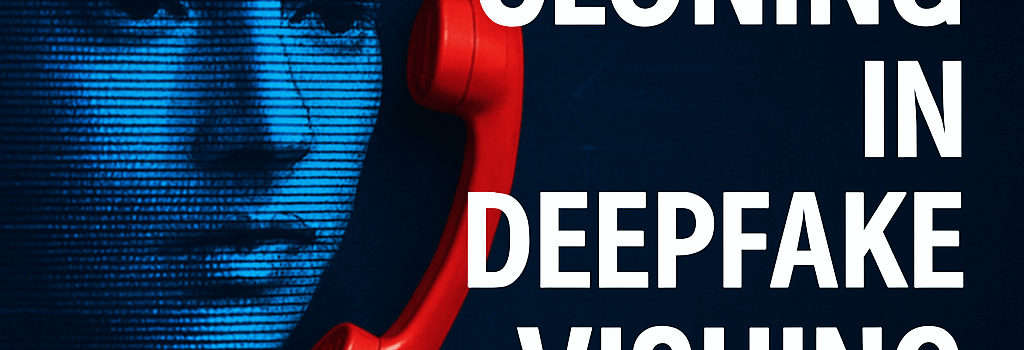AI Voice Cloning in Deepfake Vishing Attacks

By leveraging advances in speech synthesis and real-time voice transformation, attackers can now clone voices with astonishing fidelity, tricking targets into wire transfers, credential disclosure, and malware installation. We break down the full workflow, the underlying AI models, cutting-edge detection techniques, and what organizations must do today to stay ahead.
Anatomy of a Deepfake Vishing Scam
Deepfake vishing (voice phishing) combines AI-powered voice cloning engines, caller ID spoofing, and social engineering narratives to deceive victims. Below is a step-by-step overview:
- Voice Data Collection
- Attackers scrape publicly available audio from YouTube, Zoom recordings, podcasts, or social media posts.
- As little as 2–3 seconds of clear speech at 16 kHz sample rate can suffice for contemporary models.
- Model Training & Synthesis
- Popular architectures include Google’s Tacotron 2, Microsoft’s Vall-E, and ElevenLabs’ proprietary transformer models.
- These systems use sequence-to-sequence encoders plus WaveNet or GAN-based vocoders, producing real-time inference on NVIDIA T4 GPUs in under 50 ms per 20 ms audio frame.
- Service-level safeguards exist but can be bypassed by polymorphic prompts and token-stitching techniques.
- Caller ID Spoofing
- Using VoIP services or SIP proxies, attackers fake the displayed number, matching the victim’s organization or a known contact.
- Spoofing tools like Asterisk and custom SIP trunks automate large-scale campaigns.
- In-the-Wild Call Execution
- Pre-recorded approach: The attacker pushes a scripted sequence of phrases combined via digital concatenation.
- Real-time approach: Voice transformation API or open-source tools (e.g., VoiceMXNet) convert the attacker’s live speech into the target’s voice, enabling dynamic Q&A.
- Social-Engineering Narrative
- Common scenarios: urgent bail for a family member, CFO requesting emergency fund transfers, IT staff requiring password resets.
- Attackers layer in context-specific details (recent outage, policy changes) to raise credibility.
- Asset Exfiltration
- Once the victim wires money, inputs credentials, or installs malware, the operation is irreversible.
Technical Deep Dive: How Voice Cloning Models Work
Modern voice cloning pipelines typically follow a two-stage process:
- Text-to-Mel-Spectrogram Synthesis
- Encoder-decoder transformers map phoneme or grapheme sequences to mel-spectrogram frames.
- Multi-head attention layers capture prosody, intonation, and speaker identity embeddings.
- Spectrogram-to-Waveform Vocoding
- WaveNet variants or GAN-based vocoders convert spectrograms into 16-bit PCM waveforms at 24 kHz.
- Quantization and denoising filters enhance clarity, reducing artifacts that could flag a detector.
“Lower-latency inference on consumer GPUs and optimized quantized models have pushed real-time voice cloning from research to mass threat,” says Dr. Lena Ortiz, an AI researcher at SecureVoice Labs.
Detection & Mitigation Strategies
Defending against deepfake vishing demands a blend of procedural controls and technical solutions:
- Out-of-Band Verification: Always call back to a known number or use a secondary channel (SMS, encrypted messaging) before acting on urgent requests.
- Shared Passphrases: Agree on ephemeral, random code words per call—attackers cannot anticipate these in advance.
- AI-based Audio Forensics
- Deploy ML classifiers trained on artifacts (spectral inconsistencies, phase shifts) to flag synthesized speech.
- Tools like Microsoft’s Fakespotter and open-source Resonance can integrate into VoIP gateways for real-time scanning.
- Behavioral Analytics
- Monitor call metadata: unusual calling times, high concurrency, or anomalous SIP INVITE patterns.
- Implement rate limiting and anomaly-based throttling at the SBC (Session Border Controller).
Regulatory Landscape & Future Outlook
As deepfake vishing grows in sophistication, policymakers and standards bodies are racing to keep up:
- U.S. Legislation: The proposed Deepfakes Accountability Act (2025) would require digital watermarking of AI-generated media and impose penalties on misuse.
- EU AI Act: Classifies voice cloning tools under “high-risk” AI systems, mandating transparency logs and third-party audits.
- Industry Standards: The Cloud Security Alliance is drafting best practices for AI-model governance, focusing on supply chain security and usage monitoring.
“Organizations must adopt a zero-trust mindset for voice-based workflows—assume every caller is untrusted until proven otherwise,” advises CISA’s latest Incident Response Bulletin (June 2025).
Key Takeaways
- Deepfake vishing leverages state-of-the-art TTS and vocoding models to impersonate trusted voices at scale.
- Real-time voice transformation is becoming feasible on commodity GPUs, increasing threat velocity.
- A combination of human procedures (passphrases, call-backs) and technical defenses (audio forensics, behavioral analytics) is critical.
Staying ahead of AI-powered vishing requires continuous monitoring of both technological advances and evolving regulatory requirements. Organizations that implement layered defenses will reduce risk and protect critical assets from this emerging threat.